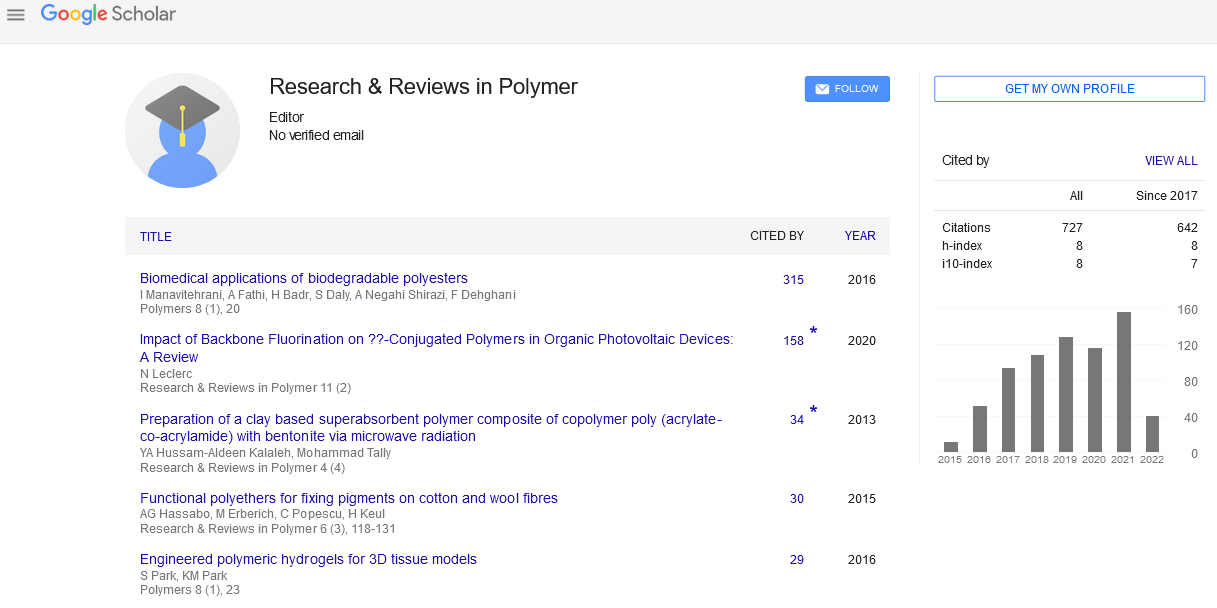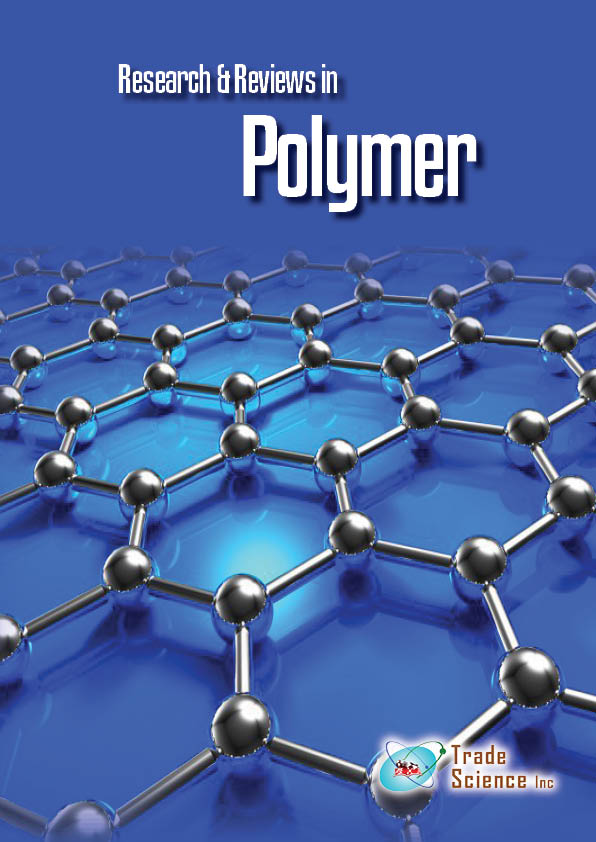Abstract
The Natural Polymer of Plant Origin its Synthetic Analogues and their Antiinflammatory and Anticancer Efficacy
Author(s): Dr. Vakhtang BarbakadzeA new polysaccharide having potent antiinflammatory and antitumor activity is the main chemical constit¬uent of high molecular (>1000 kDa) water-soluble preparations from medicinal plants of Symphytum asperum, S.caucasicum, S.officinale, S.grandiflorum, Anchusa italica, Cynoglossum officinale and Borago officinalis (Boraginaceae family). According to data of IR, liquid-state 1H, 13C NMR, APT, 1D NOE, heteronuclear 2D 1H/13C HSQC, 2D DOSY and solid-state 13C NMR spectra this biopolymer was found to be caffeic acid-derived polyether, namely poly[oxy-1-carboxy-2-(3,4-dihydroxyphenyl)ethylene] or poly[3-(3,4-dihydroxyphenyl)glyceric acid] (PDPGA). The polyoxyethylene chain is the backbone of this polymer molecule and 3,4-dihydroxyphenyl and carboxyl groups are regular substituents at two carbon atoms in the chain. This compound is the first representative of a new and important class of natural polyethers with a residue of 3-(3,4-dihydroxyphenyl)glyceric acid as the repeating unit [1-4]. Ether bonds are found in a wide variety of natural products – mainly secondary metabolites – including lipids, oxiranes, terpenoids, flavonoids, polyketides, and carbohydrate derivatives. Many of these compounds possess different biological activities of pharmacological interest. Within the field of pharmacologically active biopolymers the area of stable polyethers seems rather new and attractive [5]. PDPGA is proposed to be an important ingredient contained in folk medicines widely used in southern European countries. On the other hand PDPGA as a poly(glyceric acid) belongs to a class of an acidic polysaccharides (sugar acids) as well. Its basic monomeric moiety glyceric acid is a natural three-carbon sugar acid which is oxidative form of the simplest of all common aldoses glyceraldehyde. In this case poly(glyceric acid) chain is the backbone of this polymer molecule and 3,4-dihydroxyphenyl groups are regular substituents at carbon atoms in the chain. We have no information on the biosynthesis of such a polymer in plants, but, from the chemical viewpoint, this process can be conceived as the epoxidation of the double bond in caffeic acid followed by the polymerization of the resulting oxirane. PDPGA is the derivative of polyethylene glycol (PEG), which is the most common among polyethers and prepared by ring-opening polymerization of an oxirane (ethylene oxide). PDPGA was designed on the basis of poly[2-hydroxycarbonyl-3-(3,4-dimethoxyphenyl)oxirane] and 2-hydroxycarbonyl-3-(3,4-dihydroxyphenyl)oxirane is proposed to be an unsymmetrically 2,3-disubstituted oxirane monomer of PDPGA. Consequently, we can consider PDPGA as poly(oxiranes). Thus, PDPGA belongs to the several important classes of biopolymers and is endowed with intriguing pharmacological activities as anticomplementary, antioxidant, anti-inflammatory and anticancer properties [6-8]. Then the racemic monomer 2,3-dihydroxy-3-(3,4-dihydroxyphenyl)propionic acid (DDPPA) and its enantiomers (+)-(2R,3S)-DDPPA and (–)-(2S,3R)-DDPPA were synthesized via Sharpless asymmetric dihydroxylation of trans-caffeic acid derivatives using a potassium osmate catalyst and enantiocomplementary catalysts cinchona alkaloid derivatives (DHQ)2-PHAL and (DHQD)2-PHAL as chiral auxiliaries, respectivaly [9]. Methylated derivative of PDPGA was synthesized via ring opening polymerization of 2-methoxycarbonyl-3-(3,4-dimethoxyphenyl)oxirane using a cationic initiator BF3•OEt2 [10,11]. Hyaluronic acid (HA) (Mr 107 Da) is the main component of the extracellular matrix and is prominent in skin, vitreous of eyes, synovial fluid and periodontal connective soft tissue. HA has diverse biological activities. It is involved in processes like cell proliferation, migration and cell differentiation. The biological and pathophysiological roles of HA largely depend on its chain size. High molecular mass HA, with a molecular weight about >20 kDa, has anti-inflammatory, immunosuppressive, anti-angiogenic and space filling effects. In contrast, low molecular mass HA (<20 kDa) stimulates inflammation, invasiveness and angiogenesis by enhancing endothelial cell migration. Human Hyaluronidase (Hyal-1) is one of the main enzymes in the metabolism of HA. Hyal-1 degrades high molecular mass HA into smaller fragments, in particular tetrasaccharides. It has been shown that Hyal-1 expression is elevated in a variety of cancer cells, for example in prostate, bladder and head tumour cells. Furthermore a correlation between Hyal-1 overexpression and the malignancy of human cancer cell lines MCF-7 has been reported. Because of its role in these (patho)physiological processes, Hyal-1 is an interesting target for drug development and inhibitor testing. The inhibition of Hyal-1 using hyaluronidase inhibitors might be a new additive way in more targeted cancer treatment or in treatment of non-cancer diseases such as arthritis and gingivitis [12]. In this work, Hyal-1 was expressed on the surface of E. coli, by applying Autodisplay, to overcome formation of inactive “inclusion bodies”. With the cells displaying Hyal-1 an activity assay was performed using “stains-all” dye. Subsequently, the inhibitory effects of PDPGA on the activity of surface displayed Hyal-1 were evaluated. A stains-all assay was used to measure the inhibition of Hyal-1 by PDPGA. In order to exclude PAINS-like behavior of the polymer, inhibition of Esterase was tested as a control. As there was no inhibition at any concentration, PDPGA appeared to be selective for Hyal-1. The Live-Cell Analysis system was used to assess the effect of polymer on cell proliferation. Cytotoxicity was measured in real time. The IncuCyte® Live-Cell Analysis demonstrated the non-toxic character of PDPGA. MTT assay as performed in addition demonstrated the non-toxic character of PDPGA. Our results indicate that PDPGA possesses the ability to inhibit the enzymatic activity of Hyal-1completely. Consequently, PDPGA exhibited anti-inflammatory effect [13]. Besides its inhibitory effect on Hyal-1, PDPGA and its synthetic monomer suppressed the growth and induced death in androgen-dependent (LNCaP) and -independent (22Rv1) human prostate cancer (PCA) cells, with comparatively lesser cytotoxicity towards non-neoplastic human prostate epithelial cells PWR-1E. PDPGA and its synthetic monomer caused G1 phase arrest of cell cycle progression in PCA cells through modulating the expression of cell cycle regulators, especially an increase in cyclin-dependent kinase inhibitors (p21, p27). PDPGA induced apoptotic death by activating caspases, and also strongly decreased androgen receptor and prostate specific antigen (PSA) expression. In 22Rv1 xenograft model male athymic nude mice with 22Rv1 xenografts was administered orally of PDPGA. The tumor volume was decreased by 88%. Plasma analyses revealed that PDPGA administration caused a strong dose-dependent decrease in PSA levels by 87%. Anticancer efficacy of PDPGA against human PCA cells is more compared to its synthetic monomer DDPPA [8]. Methylated synthetic analogue of PDPGA did not show any activity against PCA. Overall, this study identifies PDPGA as a potent agent against PCA without any toxicity and supports its clinical application.
Key words: caffeic acid-derived polyether, poly[oxy-1-carboxy-2-(3,4-dihydroxyphenyl)ethylene], poly[3-(3,4-dihydroxyphenyl)glyceric acid], 3-(3,4-dihydroxyphenyl)glyceric acid, poly(glyceric acid), sugar acids, poly(oxiranes).

